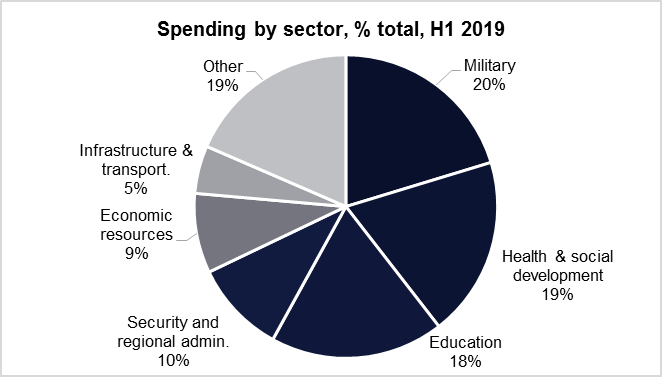
Saudi Arabia posted a budget deficit of -SAR 33.5bn (around -4.5% of estimated quarterly GDP) in Q2 2019, after recording a surplus in Q1. The deficit in Q2 2019 was significantly larger than that recorded in the same period last year.
Expenditure rose 35.2% q/q (4.7% y/y), with capital expenditure more than doubling from Q1 2019 (and up 27% y/y). Current spending rose by nearly 24% q/q on increased subsides and grants as well as government purchases of goods and services. Budget revenues grew 6.2% q/q, but were down -4.7% y/y. Oil revenues were down -5.0% y/y in Q2 2019, while lower investment income more than offset y/y growth in tax receipts.
Oil revenues in H1 2019 were up more than 15.4% y/y, while non-oil revenue grew 14.4%, despite a -21% drop in investment income, as tax receipts (VAT and taxes on expatriates) grew 48% y/y. As a result, total budget revenues grew 15.1% y/y in H1 2019, outstripping spending growth of 6.3% y/y over the period. The overall budget deficit in H1 2019 was just –SAR 5.7bn, a fraction of the –SAR 41.7bn deficit recorded in H1 2018.
The strongest growth in spending in the first half of this year was on subsidies (143% y/y), while wage growth was relatively muted at just 3.5% y/y. Interest expenses continued to rise sharply but still account for less than 2% of the total budget. Capital expenditure rose nearly 22% y/y in H1 2019, and was the highest since at least 2016.
 Source: Haver Analytics, Emirates NBD Research
Source: Haver Analytics, Emirates NBD Research
Utilities and transport infrastructure see spending boost in H1 2019
In terms of the sector breakdown of expenditure, spending on “economic resources” grew 174% y/y in H1 2019. This could include spending on some Vision 2030 mega-projects as well as development of water & sanitation infrastructure, dam construction, renewable energy and other utility projects. Spending in this sector in H1 was just one-third of the amount allocated in the budget for the whole year, so we expect spending in this area to rise further in H2 2019. The second biggest jump in spending was on infrastructure and transportation, which grew 123% y/y.
The largest share of government spending in H1 2019 (20.3% of total expenditure) went to the military sector, although the nominal amount spent declined -8.3% y/y. Spending on health & social development accounted for just over 19% of the total H1 2019 budget, and was up 13.3% y/y. This category includes spending on the construction and equipment of hospitals, primary healthcare centres, sports facilities and amusement parks.
 Source: Haver Analytics, Emirates NBD Research
Source: Haver Analytics, Emirates NBD Research
While the Q1 2019 budget surplus was a surprise, the figures at the half year mark are more in line with what we expected. Total spending was just under half our forecast for the annual budget this year, while revenue is 55% of our annual forecast. We expect spending to ramp up in H2 2019. As a result, we retain our forecast for a 2019 budget deficit of –SAR 164.4bn (-5.5% GDP), wider than the -4.6% achieved in 2018.
Click here to download the report.